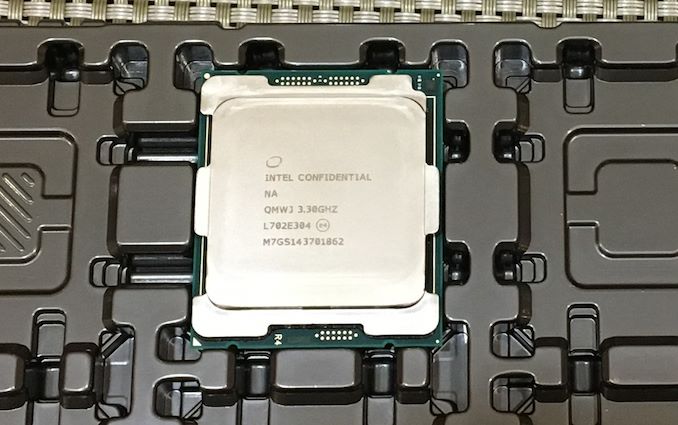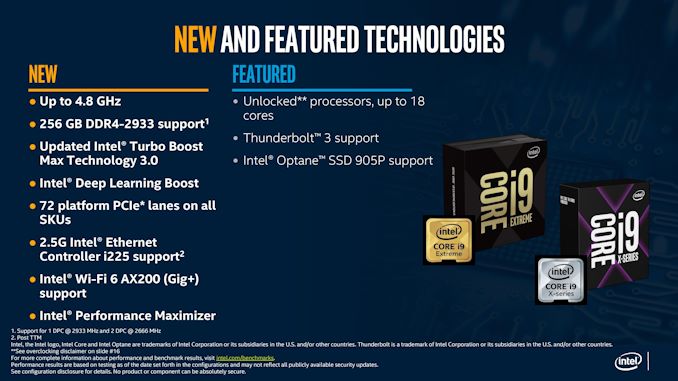Intel's Cascade Lake-X CPU for High-End Desktops: 18 cores for Under $1000
by Dr. Ian Cutress on October 1, 2019 6:35 PM EST- Posted in
- CPUs
- Intel
- HEDT
- LGA2066
- Cascade Lake

With someone in the press having broken their embargo earlier today, Intel is lifting the lid earlier than planned on their upcoming Cascade Lake-X family of processors for the high-end desktop (HEDT) market. Similar to the way Intel's Cascade Lake based Xeon Scalable processors are a further revision of their Skylake Xeons, offering clock speed increases and security fixes in hardware, the new HEDT processors will grant higher frequencies, more memory capacity, and better protection against side-channel attacks. The key numbers however are the big drop in Intel's pricing: Intel will be releasing its 18-core part, the Core i9-10980XE, for under $1000.
| Intel Cascade Lake-X | |||||||
| AnandTech | Cores Threads |
Base | All Core |
TB2 | TB3 | TDP | Price (1ku) |
| Core i9-10980XE | 18C / 36T | 3.0 | 3.8 | 4.6 | 4.8 | 165 W | $979 |
| Core i9-10940X | 14C / 28T | 3.3 | 4.1 | 4.6 | 4.8 | 165 W | $784 |
| Core i9-10920X | 12C / 24T | 3.5 | 4.3 | 4.6 | 4.8 | 165 W | $689 |
| Core i9-10900X | 10C / 20T | 3.7 | 4.3 | 4.5 | 4.7 | 165 W | $590 |
| Skylake-X (previous generation) | |||||||
| Core i9-9980XE | 18C / 36T | 3.0 | 4.5 | 4.7 | 165 W | $1979 | |
| Core i9-9940X | 14C / 28C | 3.3 | 4.5 | 165 W | $1387 | ||
| Core i9-9920X | 12C / 24T | 3.5 | 4.5 | 165 W | $1189 | ||
| Core i9-9900X | 10C / 20T | 3.5 | 4.5 | 165 W | $989 | ||
This pricing is a significant shift in Intel's strategy, and a number of fingers will be pointed at AMD as having made this happen. Next month AMD is set to launch its 16-core Ryzen 9 3950X at $749, which will offer 16 PCIe 4.0 lanes for slots (+4 for M.2, +4 for chipset) and support for 128 GB of DRAM. So Intel needed something similarly speedy, but with more PCIe lanes and more memory support that they could offer for just a bit more, leading to the 10980XE for $979. Ultimately, the on-shelf price is often just slightly higher than tray price, so don't be surprised if retail prices land at around $1000.
All the CPUs will support 256 GB of quad-channel memory (up from 128 GB), and have 48 PCIe 3.0 lanes (up from 44). Memory speed support is listed as DDR4-2933 for 1 DIMM per channel, and DDR4-2666 for 2 DIMMs per channel. All these CPUs have a TDP of 165 W, which Intel states will help the CPUs to turbo longer under Intel's recommended settings (as we know, consumer motherboard manufacturers like to ignore these anyway). All these CPUs are supported in X299 motherboards.
There is no 16-core in this stack, with Intel's official reasoning being that they assess the market with each generation and they don't believe there's a suitable price point for such a part when the 14C and 18C parts are so close. Most people will point the finger and say that no-16 core Intel part means no direct comparison with the Ryzen 9 3950X, which is something to think about.
Another point to note is that Intel has stopped this stack at the 10 core and no lower. This means that there will be no cross over between Intel's consumer processor stack and the HEDT stack, with users needing to spend just a little bit more from the Core i9-9900K/KF to reach up to the Core i9-10900X. It will be interesting to see where Intel's Core i9-9900KS fits in, although that still only has dual channel memory and 16 PCIe 3.0 lanes.
Intel lists Wi-Fi 6 and 2.5GbE support on these new processors - to clarify, Intel means external controllers here. For some odd reason when Intel says support, it could mean internal to the chipset or external via a controller; this is messaging I've railed against for a while, as it ends up confusing for enthusiasts, especially when this is an enthusiast platform. It does mean however that we get official information about Intel's 2.5GbE controllers, which we've been waiting on for a couple of years. Intel stated that these controllers will be ready at a later date, and more information to follow. (The controllers are currently listed on Intel's ARK database, but as 1 GbE controllers for some reason.)
These CPUs will have the same security mitigations as the Cascade Lake Xeon processors, with updated hardware mitigations for a number of side channel attacks. We are waiting to hear from Intel if the firmware that supports these processors will also have additional fixes in for Zombieload by default.
One question about this launch is surrounding Intel’s 14nm capacity. Within the last week, there have been reports that despite Intel’s best efforts and promises to match demand, and that Q3 and upcoming for Q4 is going to be busier than expected. We reached out to Intel last week for clarification, and the company said that the bulk of its capacity is focusing on the high-end processors in the market: the Xeon Scalable, the Core i9, Core i7, and Core i5. It will be interesting to see if launching another family of products is going to put additional strain on Intel’s capacity and demand.
With AMD's recent Zen 2 Ryzen 3000 series launch on 7nm earlier in the year, Threadripper 3 coming later this year, and Intel swinging another generation of 14++ into the high-end desktop market, Intel is going to have some tough times. Don't get me wrong, this pricing update from Intel is a good thing for users, especially those looking at implementing things like DL Boost to their workflow, but this market is suddenly turning very aggressive, and it will be interesting to see if Intel can be agile enough to keep pace.
Intel's Cascade Lake-X processors will be available in November. More details should be released nearer to launch.











162 Comments
View All Comments
eek2121 - Wednesday, October 2, 2019 - link
Threadripper has more PCIE lanes (44 for Intel vs 64 for TR). TR for Zen/Zen+ had quad channel memory, which is the same as Intel parts. You have things backwards. Zen 2 is rumored to use a new socket for at least 2 of it's parts, if not all of them. So expect the above to be the minimum spec for Zen 2 Threadrippers. We could very well see 8 channel memory and 128 lanes of PCIE similar to EPYC for the Zen 2 refresh (or we could end up with the same 2, 64 config).nevcairiel - Thursday, October 3, 2019 - link
I obviously compared lanes and memorty to Ryzen, not TR, as the first 5 words in my comment clearly state, but thanks for playing.TR was mentioned later for its potential single-thread deficits, but we'll have to see how that turns out in TR 3000.
Irata - Thursday, October 3, 2019 - link
Actually, Ryzen 2 does not have less PCIe bandwidth than Cascade X - 24 PCIe 4 = 48 PCIe 3.The fact that Intel's high end platform is now being compared to AMD's mainstream platform also shows one reason why prices were lowered.
jakky567 - Wednesday, October 2, 2019 - link
Presumably threadripper 3000 takes both ST/MT crowns. The clock speeds tend to be quite high and the increased power budget helps.9700k or the 9900k are the only chips with sometimes superior single threaded performance to the 3900x.
You can't maintain those sort of clocks monolithic.
Korguz - Wednesday, October 2, 2019 - link
nevcairiel " In comparison to Ryzen 3000, there is of course also more memory channel and PCIe lanes, and in comparison to low-end Thread Rippers likely going to be a big ST advantage. "too bad you need to compare these cpus to threadripper NOT ryzen 3000.
nevcairiel - Thursday, October 3, 2019 - link
I compare to what I wish to compare to. What would you like to compare a 12-core or 16-core Ryzen to then?Also rumors say that TR will start with 24-cores, possibly to not conflict with 16-core Ryzen. 24-core TR and 10-18 Core Intel HDT are different market segments, honestly.
Korguz - Thursday, October 3, 2019 - link
and that would be where you are wrong. comparing hedt to mainstream is like comparing a porsche 911 rurba to a boxter."What would you like to compare a 12-core or 16-core Ryzen to then? " oh i dont know... the 9900k/x maybe ??
they are not in different markets.. they are both hedt platforms
Sahrin - Wednesday, October 2, 2019 - link
Unfortunately as we’ve seen the AVX512 advantage washes out with Intel’s core throttling. Can’t cut global frequency 30% and expect to win benchmarks.psychobriggsy - Wednesday, October 2, 2019 - link
The other issue is that when you have twice as many CPU cores in your processor, AVX256 at full speed can perform as well as AVX512 on the processor with fewer cores. Intel recently added AVX256 to a video encoding library that was previously smashing it with AVX512 on Intel, and ThreadRipper suddenly became more than competitive (seen at Phoronix).Which means again that a developer might as well spend their time optimising for AVX256 which is far more common than AVX512.
imaheadcase - Wednesday, October 2, 2019 - link
Um but who throttles a CPU at full load..no one.